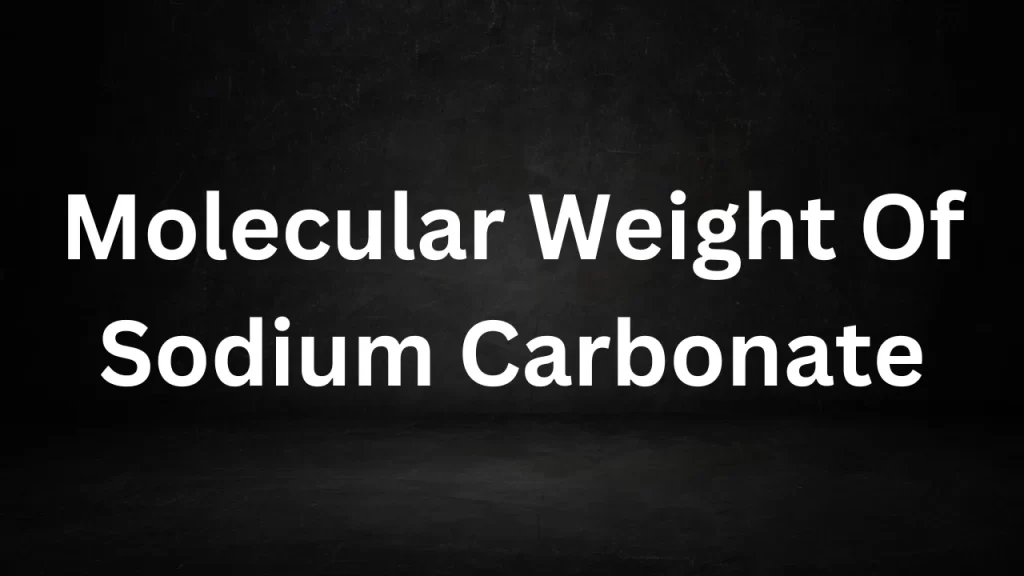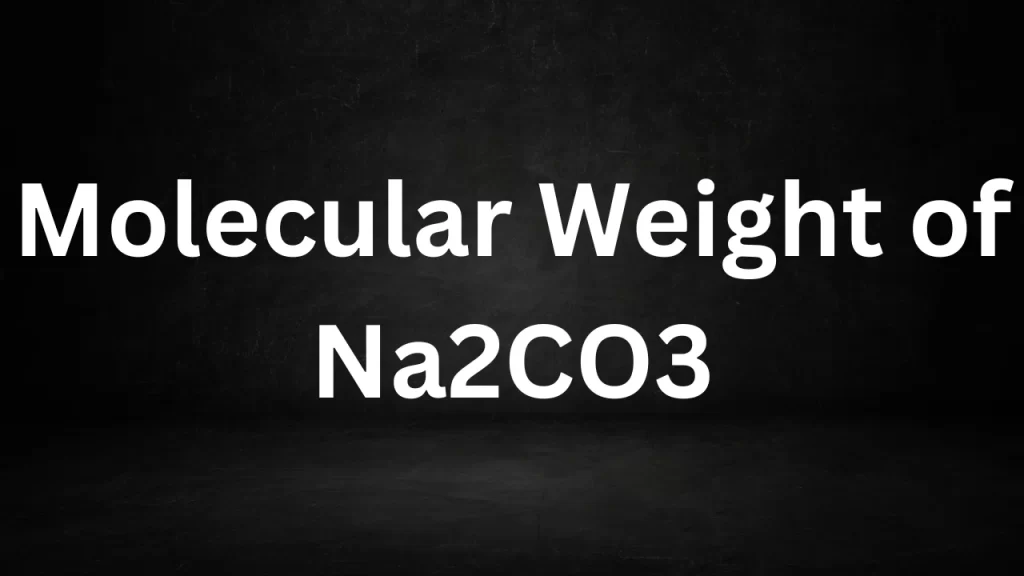Tag: naco3 mw
Molecular Weight Of Sodium Carbonate
Molecular Weight Of Sodium Carbonate: Sodium carbonate, commonly known as soda ash or washing soda, is a chemical compound with the molecular formula Na2CO3.
Understanding its molecular weight is fundamental in various fields, including chemistry, industry, and environmental science.
In this article, we delve into the concept of molecular weight and explore the significance of knowing the molecular weight of sodium carbonate.

Molecular Weight Of Sodium Carbonate
Definition of Molecular Weight
Molecular weight, also known as molar mass or molecular mass, is a measure of the mass of a molecule. It is defined as the sum of the atomic weights (masses) of all the atoms in a molecule. The unit of molecular weight is the atomic mass unit (amu) or unified atomic mass unit (u). For convenience, molecular weights are often expressed in grams per mole (g/mol).
Calculating the Molecular Weight of Sodium Carbonate
To calculate the molecular weight of sodium carbonate (Na2CO3), we need to sum the atomic weights of all the constituent atoms:
- Sodium (Na) has an atomic weight of approximately 22.99 amu.
- Carbon (C) has an atomic weight of roughly 12.01 amu.
- Oxygen (O) has an atomic weight of about 16.00 amu.
Now, let’s calculate the molecular weight:
Molecular Weight of Na2CO3 = (2 * Atomic Weight of Na) + Atomic Weight of C + (3 * Atomic Weight of O)
Molecular Weight of Na2CO3 = (2 * 22.99 amu) + 12.01 amu + (3 * 16.00 amu)
Mole Weight of Na2CO3 ≈ 45.98 amu + 12.01 amu + 48.00 amu
Mole Weight of Na2CO3 ≈ 105.99 amu (or g/mol)
So, the molecular weight of sodium carbonate is approximately 105.99 g/mol.
Significance of Mole Weight of Sodium Carbonate
Understanding the mole weight of sodium carbonate holds several practical implications:
- Chemical Formulation: The mole weight provides the exact mass of one mole of sodium carbonate molecules. This is essential for precise chemical formulations and reactions in laboratories and industries.
- Stoichiometry: In chemical reactions, the molecular weight plays a crucial role in stoichiometry, helping scientists and engineers determine the quantities of reactants and products.
- Dosage Calculation: In various applications, such as water treatment and detergents, the molecular weight is vital for calculating the appropriate dosage of sodium carbonate needed to achieve specific results.
- Environmental Impact: In environmental science, understanding the molecular weight aids in assessing the impact of sodium carbonate on ecosystems and water quality when it is used or released.
- Quality Control: Industries that produce sodium carbonate products rely on accurate molecular weight data to maintain quality control standards.
In conclusion, the mole weight of sodium carbonate, approximately 105.99 g/mol, is a crucial parameter in various scientific, industrial, and environmental contexts. It enables precise calculations, formulations, and assessments, ultimately contributing to the efficient and responsible use of this important chemical compound.
Read More
- Difference Between Isothermal And Adiabatic Process
- Simple Harmonic Motion Examples
- Molecular Mass Of Calcium
- Lumen Meaning In Biology
- Molar Mass of Chlorine
Frequently asked questions (FAQs) On Mole Weight Of Sodium Carbonate
1. What is the mole formula of sodium carbonate?
The mole formula of sodium carbonate is Na2CO3, indicating that each molecule contains two sodium (Na) atoms, one carbon (C) atom, and three oxygen (O) atoms.
2. What is the mole weight of sodium carbonate?
The mole weight of sodium carbonate (Na2CO3) is approximately 105.99 grams per mole (g/mol).
3. Why is it important to know the mole weight of sodium carbonate?
Knowing the mole weight is essential for accurate chemical calculations, including determining reactant and product quantities in chemical reactions, dosage calculations in various applications, and quality control in industries.
4. How is the mole weight of sodium carbonate calculated?
The mole weight of sodium carbonate is calculated by summing the atomic weights of all the constituent atoms in its chemical formula: 2 * Atomic Weight of Sodium (Na) + Atomic Weight of Carbon (C) + 3 * Atomic Weight of Oxygen (O).
5. What are some common uses of sodium carbonate in everyday life?
Sodium carbonate has a wide range of applications, including as a cleaning agent (in laundry detergents and household cleaners), in water treatment, as a food additive, and in various industrial processes.
Molecular Weight of Na2CO3
Molecular Weight of Na2CO3: Sodium carbonate, with the chemical formula Na2CO3, is a compound commonly known as soda ash or washing soda.
It plays a significant role in various industrial processes and applications, including glass production, detergent manufacturing, and water treatment.
Understanding the molecular weight of Na2CO3 is essential for both theoretical and practical purposes. In this article, we will explore the molecular weight of sodium carbonate and its significance in chemistry and industry.

Molecular Weight of Na2CO3
The Composition of Sodium Carbonate (Na2CO3)
Before diving into the molecular weight of sodium carbonate, let’s break down its chemical composition:
- Sodium (Na): Sodium has an atomic mass of approximately 22.99 atomic mass units (amu).
- Carbon (C): Carbon has an atomic mass of approximately 12.01 amu.
- Oxygen (O): Oxygen has an atomic mass of approximately 16.00 amu.
- Sodium carbonate (Na2CO3) consists of two sodium atoms (Na), one carbon atom (C), and three oxygen atoms (O).
Calculating the Molecular Weight of Na2CO3
To find the molecular weight of sodium carbonate (Na2CO3), we sum the atomic masses of its constituent atoms according to the chemical formula:
Molecular Weight of Na2CO3 = (2 × Atomic Mass of Na) + Atomic Mass of C + (3 × Atomic Mass of O)
The Molecular Weight of Na2CO3 = (2 × 22.99 amu) + 12.01 amu + (3 × 16.00 amu)
Molecular Weight of Na2CO3 = 45.98 amu + 12.01 amu + 48.00 amu
Molecular Weight of Na2CO3 ≈ 105.99 amu
So, the mol weight of sodium carbonate (Na2CO3) is approximately 105.99 atomic mass units (amu) or 105.99 grams per mole (g/mol).
Significance of Molecular Weight in Sodium Carbonate
The mole weight of sodium carbonate is crucial for several reasons:
- Stoichiometry: In chemical reactions involving sodium carbonate, its molecular weight is used to calculate the amounts of reactants and products. This is essential for balancing chemical equations and determining reaction yields.
- Dosing in Water Treatment: Sodium carbonate is used in water treatment to adjust pH levels and soften water. Knowledge of its molecular weight helps in dosing calculations to achieve the desired treatment results.
- Manufacturing Processes: Industries such as glass manufacturing and detergent production rely on sodium carbonate as a key ingredient. Accurate molecular weight values are vital for quality control and formulation.
- Analytical Chemistry: In analytical chemistry, sodium carbonate can be used as a standard for titrations. Precise molecular weight values are essential for accurate analytical procedures.
Conclusion
The mole weight of sodium carbonate (Na2CO3), approximately 105.99 amu or 105.99 g/mol, is a fundamental property that underlies its various applications in chemistry and industry. Whether used as a reactant in chemical processes, a water treatment agent, or an essential component in manufacturing, understanding the molecular weight of sodium carbonate is essential for ensuring the efficiency and effectiveness of these processes. This versatile compound continues to be a vital player in numerous industrial and scientific endeavors.
Read More
- Molecular Mass Of Sodium
- Molecular Mass of Sucrose
- Molecular Mass of Chlorine
- Molar Mass Of C2H5OH
- Molecular Weight of Co2
Frequently Asked Questions (FAQs) Molecular Weight of Na2CO3
What is the mole weight of Na2CO3?
The mole weight of sodium carbonate (Na2CO3) is approximately 105.99 atomic mass units (amu) or 105.99 grams per mole (g/mol). It is calculated by adding the atomic masses of its constituent atoms according to the chemical formula.
Why is it important to know the molecular weight of Na2CO3?
Knowing the molecular weight of sodium carbonate is crucial for various reasons, including stoichiometry in chemical reactions, dosing in water treatment, formulation in manufacturing processes, and analytical chemistry procedures.
What are some common uses of sodium carbonate (Na2CO3)?
Sodium carbonate, also known as soda ash or washing soda, is used in a wide range of applications. It is used in glass production, detergent manufacturing, water treatment for pH adjustment, and as a cleaning agent in household and industrial settings.
How is the mole weight of Na2CO3 calculated?
The mole weight of Na2CO3 is calculated by summing the atomic masses of its constituent atoms. In the case of sodium carbonate, you add the atomic masses of two sodium (Na) atoms, one carbon (C) atom, and three oxygen (O) atoms.
Can sodium carbonate be used in food or as a food additive?
Yes, sodium carbonate is used in the food industry as a food additive with the code E500. It is used in some food products, including baked goods, as a leavening agent to help dough rise.
Molecular Weight Of Carbon
Molecular Weight Of Carbon: Hydrogen, the first element on the periodic table, holds a special place in the world of chemistry and physics due to its simplicity and ubiquity in the universe. One of the key characteristics that defines hydrogen is its molecular weight, a fundamental property that influences its behavior, applications, and significance in various scientific fields.

Molecular Weight Of Carbon
The Atomic Weight of Hydrogen
Before delving into the molecular weight of hydrogen, it’s essential to understand the atomic weight of a single hydrogen atom. The atomic weight of an element is essentially a weighted average of its isotopes, and hydrogen has three isotopes: protium (¹H), deuterium (²H or D), and tritium (³H or T). However, the atomic weight commonly associated with hydrogen is approximately 1.008 amu (atomic mass units), which corresponds to the most abundant isotope, protium.
Molecular Weight of Hydrogen (H₂)
The molecular weight of hydrogen is calculated by considering a molecule of hydrogen gas, H₂, which consists of two hydrogen atoms. Since each hydrogen atom has an atomic weight of approximately 1.008 amu, the calculation is straightforward:
Molecular Weight of Hydrogen (H₂) = 2 × Atomic Weight of Hydrogen ≈ 2.016 g/mol
Hence, the molecular weight of hydrogen gas (H₂) is approximately 2.016 grams per mole (g/mol). This value is incredibly low, making hydrogen the lightest element and the lightest molecule known.
Significance of Hydrogen’s Low Molecular Weight
The low molecular weight of hydrogen is a defining characteristic that has profound implications across various scientific domains:
- Efficient Fuel: Hydrogen’s low molecular weight contributes to its role as an efficient fuel source. In combustion reactions, hydrogen releases a high amount of energy per unit mass, making it an ideal choice for rockets, fuel cells, and clean energy solutions.
- Buoyant Gas: Hydrogen’s low density relative to air gives it buoyancy. In the early days of aviation, hydrogen-filled airships, such as the infamous Hindenburg, were used for transportation. However, safety concerns due to hydrogen’s flammability led to the adoption of helium, a non-flammable alternative.
- Chemical Reactivity: The low molecular weight of hydrogen results in high chemical reactivity. It readily reacts with various elements, including oxygen, forming water (H₂O) in combustion reactions. Its reactivity is fundamental in numerous chemical processes and industrial applications.
Conclusion
The molecular weight of hydrogen, approximately 2.016 g/mol, is a fundamental property that defines the behavior and applications of this remarkable element. Its lightness, efficiency as a fuel, and widespread availability make it a subject of immense interest in scientific research and technological advancements. Understanding hydrogen’s molecular weight is essential for harnessing its potential as a clean energy source, propelling space exploration, and exploring new frontiers in chemistry and physics.
Read More
- Molecular Weight Of Hydrogen
- Molecular Weight Of Urea
- Molecular Mass Of Urea
- Molecular Mass Of Hydrogen
- Molecular Mass Of Nacl
Frequently Asked Questions (FAQs) Molecular Weight Of Carbon
1. What is the molecular weight of carbon?
The molecular weight of carbon is approximately 12.011 grams per mole (g/mol). This value represents the mass of one mole of carbon atoms and is used as a basis for calculating the molecular weights of various carbon-containing compounds.
2. How is the molecular weight of carbon calculated?
The mol weight of carbon is calculated based on the atomic weight of a carbon atom. Carbon has several isotopes, but the most common isotope is carbon-12 (¹²C), which has an atomic weight of exactly 12 atomic mass units (amu). Therefore, the molecular weight of carbon is equal to the atomic weight of carbon-12:
mol Weight of Carbon = Atomic Weight of Carbon-12 ≈ 12.011 g/mol
3. Why is the molecular weight of carbon important in chemistry?
The mol weight of carbon is a fundamental property that influences the mol weights of organic and inorganic compounds. It serves as a reference point for determining the mass of carbon atoms in various molecules, enabling chemists to calculate and compare the masses of different compounds.
4. Does the molecular weight of carbon vary for different isotopes of carbon?
Yes, the mol weight of carbon can vary slightly when considering different carbon isotopes. While the most common isotope, carbon-12 (¹²C), has an atomic weight of exactly 12 amu, other isotopes like carbon-13 (¹³C) and carbon-14 (¹⁴C) have slightly different atomic weights. However, in most chemical calculations and applications, the atomic weight of carbon-12 is used for simplicity.
5. How is the molecular weight of carbon relevant in organic chemistry?
In organic chemistry, carbon is the backbone of organic compounds. The mol weight of carbon is crucial for determining the molecular weights of organic molecules and calculating stoichiometry in chemical reactions. It plays a central role in understanding the composition and properties of organic compounds.